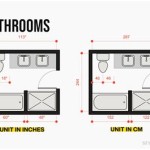Is It Expensive To Add a Bathroom to Your House? Decoding the Costs
Adding a bathroom to a house is a substantial home improvement project that can significantly increase property value and enhance daily living. However, prospective homeowners must understand the financial implications before embarking on such a venture. The cost of adding a bathroom can vary widely, influenced by several factors ranging from the bathroom's size and location to the materials chosen and the complexity of the plumbing and electrical work involved. This article aims to dissect the various cost components associated with adding a bathroom, providing a comprehensive understanding of the financial commitments involved.
One of the first realizations homeowners encounter is that adding a bathroom is not simply a matter of installing a toilet and sink. Existing plumbing and electrical systems must be assessed and potentially altered to accommodate the new fixtures. This necessitates careful planning and the involvement of qualified professionals, each contributing to the overall expense. Furthermore, local building codes and permit requirements add another layer of complexity and cost, ensuring the project adheres to safety and regulatory standards.
The subsequent sections will delve into the key cost drivers, shedding light on the factors that can significantly inflate or potentially mitigate the overall expenditure. By carefully considering each element, homeowners can develop a realistic budget and make informed decisions throughout the project, aiming to maximize value while minimizing unexpected expenses.
Location, Location, Location: The Impact of Placement on Cost
The location of the new bathroom within the house plays a crucial role in determining the overall cost. Adding a bathroom adjacent to existing plumbing lines is significantly less expensive than adding one in a location where new lines must be run. The proximity to the main water supply and drain lines dramatically impacts the labor involved in plumbing installation, a significant cost component.
When a bathroom is situated far from existing plumbing, extensive pipework is required to connect the new fixtures to the water supply and drain lines. This might necessitate cutting into walls, floors, and ceilings, leading to additional labor costs for demolition, installation, and subsequent repairs. In some cases, the existing water heater might need to be upgraded to handle the increased demand, further increasing expenses. The difficulty of accessing the desired location also factors into the equation. Cramped spaces or difficult-to-reach areas can slow down the work and increase labor hours.
Adding a bathroom in a basement, for instance, can present unique challenges. If the waste line is above the level of the new bathroom fixtures, a grinder pump will be necessary to pump waste upwards to the main sewer line. This adds another layer of expense and complexity to the project. Additionally, basements may require extra waterproofing to prevent moisture issues, which can also contribute to the overall cost.
Conversely, converting an existing space, such as a large closet or unused bedroom, into a bathroom can be more cost-effective, especially if the space is already near existing plumbing. These conversions minimize the amount of new plumbing required and can significantly reduce labor costs. Careful consideration of location, therefore, is paramount in controlling the overall cost of adding a bathroom.
Fixtures and Finishes: Where Your Budget Can Stretch (or Shrink)
The selection of bathroom fixtures and finishes significantly impacts the overall project cost. From toilets and sinks to showers, bathtubs, tiles, and lighting, the choices made within this category can dramatically influence the final price tag. High-end fixtures and designer finishes can easily double or even triple the cost compared to standard, builder-grade options.
Toilets, for example, range in price from basic models costing a few hundred dollars to high-efficiency or smart toilets that can cost several thousand dollars. Similarly, sinks can range from simple pedestal sinks to elaborate vanity units with custom countertops. The choice between a standard shower stall and a custom-tiled walk-in shower will also have a significant impact. Bathtubs, especially freestanding or jetted tubs, are often a substantial expense.
Tile selection can also lead to considerable cost variation. Basic ceramic or porcelain tiles are typically the most affordable options, while natural stone, glass, or mosaic tiles can be significantly more expensive. Installation costs also vary depending on the type of tile and the complexity of the pattern. Lighting fixtures, from basic vanity lights to recessed lighting and decorative chandeliers, also contribute to the overall aesthetic and cost.
To manage costs, homeowners can consider a tiered approach to fixture and finish selection. Opting for more affordable options in less visible areas, such as within the shower enclosure, while investing in higher-quality fixtures for focal points, such as the vanity or lighting, can strike a balance between aesthetics and budget. Shopping around and comparing prices from different suppliers is also crucial in securing the best deals on desired items. Furthermore, considering alternative materials, such as vinyl flooring instead of tile, can further reduce expenses without compromising functionality.
Labor and Permits: Essential Costs Often Overlooked
Labor costs constitute a significant portion of the overall expense when adding a bathroom. This includes the fees charged by plumbers, electricians, carpenters, tile installers, and general contractors, all of whom are essential for ensuring the project is completed safely and to code. Obtaining the necessary permits from local authorities is another crucial aspect, and the associated fees should be factored into the budget.
Plumbers are essential for connecting the new fixtures to the water supply and drain lines, installing the toilet, sink, shower, and bathtub. Their expertise is critical in ensuring proper water pressure, drainage, and preventing leaks or other plumbing issues. Electricians are responsible for installing electrical outlets, lighting fixtures, and ensuring the bathroom meets electrical safety codes, including proper grounding and GFCI protection. Carpenters may be needed for framing walls, installing doors and windows, and building custom cabinetry or shelving.
Tile installers are responsible for properly preparing the subfloor, applying mortar, and setting the tiles in a precise and aesthetically pleasing manner. General contractors are often hired to manage the entire project, coordinating the various tradespeople, ensuring the project stays on schedule and within budget, and handling any unexpected issues that may arise. Their fees typically include a markup on the cost of materials and labor, but their expertise can be invaluable in ensuring a smooth and successful project.
Permit fees vary depending on the location and the scope of the project. Failure to obtain the necessary permits can result in fines, delays, and even the requirement to tear down and rebuild non-compliant work. It is essential to research local building codes and permit requirements before starting any work to avoid these potential pitfalls. Furthermore, professional contractors typically handle the permit application process, reducing the burden on the homeowner and ensuring all necessary paperwork is properly submitted.
To manage labor costs, obtaining multiple quotes from different contractors is highly recommended. Carefully reviewing the quotes and comparing the scope of work, materials, and payment schedules can help homeowners identify the best value for their money. It's also important to check the contractor's licenses, insurance, and references to ensure they are qualified and reputable. While it may be tempting to attempt some of the work oneself to save money, it is generally advisable to leave complex plumbing and electrical work to licensed professionals to avoid potential safety hazards and code violations.
In summary, the cost of adding a bathroom to a house is complex and multifaceted. Location, fixtures and finishes, labor, and permits all contribute significantly to the overall expense. Careful planning, thorough research, and a realistic budget are essential for a successful and cost-effective bathroom addition project.

Cost To Add A Bathroom 2024 Guide Forbes Home

How Much Does An Extra Bathroom Add To The Value Of A House Resi
:strip_icc()/housesprucingbathroom3-7b0fca1959964b7cbcc866ada820aba3.jpeg?strip=all)
This Is How Much It Costs To Add A Bathroom

What S The Average Cost To Add A Bathroom Neighborly

How Much Does It Cost To Add A Bathroom Or Bedroom

How Much Does It Cost To Add A Bathroom 2024 Data

How Much To Add A Bathroom Cost Guide Trelora Real Estate

Bathroom Remodeling How Much Does It Cost To Add A

What Is The Cost To Add A Half Bathroom Badeloft

Increase The Value Of Your Home With Roi A Bathroom
Related Posts






